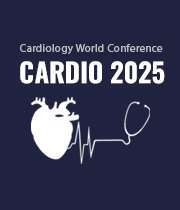Title : Pulmonary hypertensive crisis and severe right ventricular dysfunction secondary to protamine use post-heart transplantation: A case report
Abstract:
Protamine, a low-molecular-weight protein derived from salmon sperm, is used as a specific antagonist of unfractionated heparin, particularly in settings such as cardiac surgery (1). Although adverse reactions, mostly of immunologic origin, are relatively uncommon (0.1%–10%) (1,2), they can be fatal, especially when associated with severe right ventricular dysfunction and pulmonary vasoconstrictive crises (2).
A 35-year-old woman with advanced heart failure (HF) secondary to arrhythmogenic right ventricular cardiomyopathy, associated with a likely pathogenic heterozygous mutation in the desmoplakin gene, was admitted with congestive symptoms, a decline in LVEF (from 45% to 20%), and electrical instability requiring ICD discharges. She developed low cardiac output and underwent inotropic support with milrinone and renal replacement therapy due to refractory congestion. Her condition progressed to multiorgan failure and electrical storm, necessitating urgent VA-ECMO and successful emergency heart transplantation.
Following weaning from cardiopulmonary bypass, anticoagulation was reversed with protamine sulfate, resulting in immediate profound hypotension, acute pulmonary hypertension (systolic PAP 80 mmHg), and marked RV dilation, culminating in cardiac arrest. She underwent direct cardiac massage, re-heparinization, and re-initiation of extracorporeal circulation. Hemodynamic support was intensified with norepinephrine, dobutamine, and inhaled nitric oxide for pulmonary vasodilation. RV function gradually recovered, allowing for progressive reduction of pulmonary pressures and eventual weaning from extracorporeal support. Forty-eight hours later, sternal closure was performed. After 96 hours of pharmacologic support and renal replacement therapy, full recovery was observed. Hemodiafiltration was discontinued, and the patient was discharged from the ICU without complications. Right heart catheterization confirmed normal hemodynamic graft function, and endomyocardial biopsy showed no signs of rejection.
Although rare, acute pulmonary hypertension and right ventricular failure induced by protamine represent clinically devastating complications. The pathophysiology and optimal management remain unclear. Immunologic mechanisms involving IgE and IgG antibodies targeting protamine or heparin-protamine complexes have been proposed, resulting in complement activation and release of anaphylatoxins (C3a, C5a), which stimulate the release of potent pulmonary vasoconstrictors such as thromboxane A? and leukotrienes (3,4). This type III hypersensitivity reaction is characterized by a sudden and severe increase in PAP due to massive pulmonary vasoconstriction, leading to RV dysfunction, hemodynamic collapse, and potentially death (2,5). The clinical course is abrupt and rapidly progressive, independent of the protamine dose or infusion rate (2). Management should aim to reduce pulmonary afterload and stabilize RV function through pharmacologic strategies including inotropes, vasopressors, and pulmonary vasodilators such as inhaled nitric oxide—the first-line therapy (6). Other agents like prostacyclins (Epoprostenol) and mechanical circulatory support or return to cardiopulmonary bypass may be necessary until RV recovery is achieved (5-7).
The severity of these complications highlights the importance of maintaining a high index of suspicion for unexpected hemodynamic deterioration following protamine administration, enabling early recognition and timely intervention to mitigate the risk of fatal outcomes.



